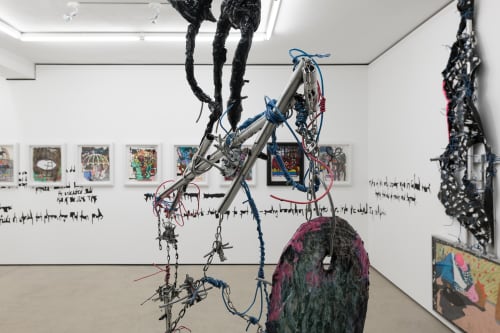Dolls with a wide smile lie carelessly thrown down on the floor in twisted poses. Inspired by Haba retro-style toys – “Inventor for inquisitive minds”– they have become the choice for liberal American parents. Like the children’s book character "Raggedy Andy,“ they seem to come to life when nobody is present. A metal structure strives upwards like a massive antenna out of the drawings’ frame, wrapped around by sloppy black-checkered canvas and sutures of blue vinyl wire. A hint of technocracy gives the innocent doll images something of snapshots of a monitoring camera in a children’s room. Where protection crosses the fine line into panopticism, imposed constraints petrify the unleashed souls and at the same time spark their inflammatory disobedience.
A stylistically incongruous aesthetic between punk and pop feeds on utensils, text phrases, toys, and teen props – from sweatshirts, studded belts, to sports logos – sparking brainchildren that at times dive into the abyss. In ritualistic acts of reanimation, Eilers and his accomplices tear apart and reassemble fetishised consumer items into new objects of desire. Perpetual recycling processes here reveal and subvert the transition from exchange-value to “sign-value,” fueling the ongoing reworking of longing through images.
Having to balance improvisation and regimentation of play sabotages myths of the only creator ego in Eiler’s work, toppling statutes of master and servant: a struggle between oneself and the other for autonomy. Relying on their own time, order, and justice, those childlike free plays and games might heal the wounds of the adult world. Standing out against the dullness of ordinary life, they are usually safely locked away on designed places – playgrounds staggering between utopia and imaginary jails.
The city streets are unsatisfactory playgrounds because of the danger, and because most good games are against the law.1 Disappointment, however, makes way for edification and enjoyment … the uncertainty of the course of the game, the theoretical possibility of bitter seriousness, the collision with the rules stirs its actual subversive charm. Crimes, in the adult world, are games played for the material rewards, the take. But in the child’s world, it is just the thrill of the chase: the getaway and the cool-off.
Curated by Elisa R. Linn
Debo Eilers (born 1974 in Texas) lives and works in New York. In addition to his solo work, Eilers involves artists and others as collaborators in joint projects (e.g. Nic Xedro 2006-2009, Professor Eilers 2009-2012). In 2010, he and the artist Kerstin Brätsch initiated the ongoing collaborative project KAYA.
Debo Eilers was invited to this years Whitney Biennial at the Whitney Museum of American Art in New York, USA. Eilers had solo and group exhibitions in venues such as KUB Kunsthaus Bregenz, Bregenz; mumok, Vienna (all Austria); Kunstverein Munich; Neuer Aachener Kunstverein, Aachen; Museum Brandhorst, Munich; Fridericianum, Kassel (all Germany); Palais des Beaux-Arts de Lille, Lille, France; MoMA PS1, New York; LAX ART, Los Angeles; On Stellar Rays, New York; 47 Canal, New York (all USA); M. Woods, Bejing, China and Gio Marconi, Milan, Italy.
Works of Debo Eilers are part of the collections of Museum Brandhorst, Munich, Germany; Stedelijk Museum, Amsterdam, Netherlands and the Tang Teaching Museum and Art Gallery, Saratoga Springs, NY.

